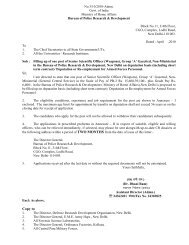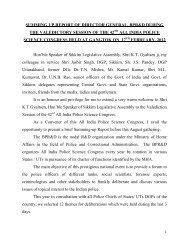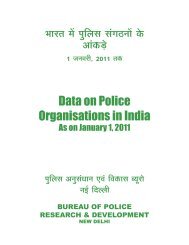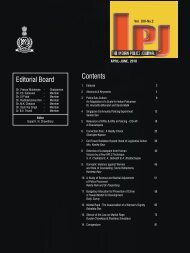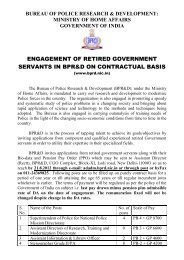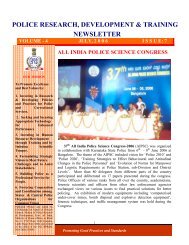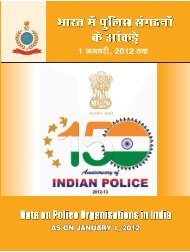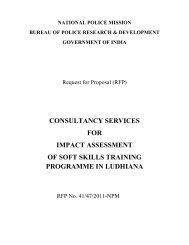the-scenes role played by the DIB in respect <strong>of</strong>the Cabinet approval for pay parity betweenthe State DGP <strong>and</strong> the Chief Secretary. At thisjuncture, I strongly recommended the setting up<strong>of</strong> an ‘Indian <strong>Police</strong> Foundation’, a dream projectthat should be one <strong>of</strong> the main concerns <strong>of</strong> theDelhi based Association <strong>of</strong> Retired Senior I.P.S.Officers, presently presided over by Shri A.K.Verma <strong>and</strong> ably guided by <strong>Police</strong> stalwarts likeShri B.S. Das <strong>and</strong> G.C. Saxena.In the end, what makes the IB, regarded as theoldest National Security Organisation, retain itscharm <strong>and</strong> attraction, even now, is that this is anorganisation; thanks to its strong leadership overdecades, that has remained non-controversial,mainly because <strong>of</strong> its highly pr<strong>of</strong>essional <strong>and</strong>unbiased approach <strong>and</strong> conduct. No wonder, it isone <strong>of</strong> the few organisations that zealously guards<strong>and</strong> retains its credibility, believing as it does, inquiet efficiency without any craving, whatsoever,for publicity or populism. In lB, reputations arebuilt over a period <strong>of</strong> time, even decades, throughhard meritorious work <strong>and</strong> no one parachutesto the top on extraneous considerations. In amanner <strong>of</strong> saying, lB <strong>and</strong> its <strong>of</strong>ficers believe in the‘ladder <strong>and</strong> staircase approach’ to the top. Also,the congenial environment within the lB over theyears has not allowed any divergence <strong>of</strong> opinion<strong>and</strong> approach amongst its leadership to degenerateinto ill will or rancour. It is a happy family with alarge number <strong>of</strong> high achievers, past <strong>and</strong> present,which is constantly blessed by its elders.My journey through the lB, I reckon, has been acontinuation <strong>of</strong> my journey in the l.P.S. To methe two are integrally intertwined. To the query,if given another chance, may be in next birth,would I like to repeat this journey, my answer isan emphatic ‘yes’. Long live the <strong>Bureau</strong> to pursueits basic charter <strong>of</strong> ‘Protection <strong>of</strong> the Constitution<strong>of</strong> India’.(C.V. Venkatraman)86The Indian <strong>Police</strong> Journal, October - December, 2012, Special Issue
Observations on India’s State <strong>and</strong>Central Intelligence ApparatusShri K.P.S. Gill, IPS (Retd.)When I look back on my 38-year career inPolicing, including positions in some <strong>of</strong> themost troubled areas <strong>of</strong> the country, in their mosttroubled <strong>of</strong> times, I am astonished at the verylimited interface I have had with India’s centralintelligence apparatus. I am, indeed, quiteamused when I hear <strong>Police</strong> leaders from acrossthe country — particularly after a terrorist attackor other major security debacle — complain, forinstance, that the Intelligence <strong>Bureau</strong> had notprovided them with ‘actionable intelligence’ thatcould have allowed them to prevent or betterdeal with specific incidents (these grumblesare quickly picked up <strong>and</strong> amplified by thepolitical executive <strong>and</strong> the media). lB inputs <strong>and</strong>advisories are, <strong>of</strong> course, the staple <strong>of</strong> Policingin the country, but were hardly pivotal in State<strong>Police</strong> responses to security threats or crises, atleast in my experience.I underst<strong>and</strong>, <strong>of</strong> course, that things have changedsomewhat since then. Many terrorist <strong>and</strong> organisedcriminal enterprises now have trans-borderdimensions, both across a multiplicity <strong>of</strong> States inIndia <strong>and</strong> <strong>of</strong>ten across international borders. Centralagencies, particularly including the Intelligence<strong>Bureau</strong>, the <strong>Research</strong> <strong>and</strong> Analysis Wing <strong>and</strong> theNational Technical <strong>Research</strong> Organisation, have aspecific m<strong>and</strong>ate <strong>and</strong> technical <strong>and</strong> technologicalcapabilities that are not available to the State<strong>Police</strong> apparatus, <strong>and</strong>, consequently, the Stateshave developed a certain dependence on inputsfrom these organisations. This is not, however, anecessary or natural consequence <strong>of</strong> the evolvingnature <strong>of</strong> crime <strong>and</strong> terrorism, but is, rather, anindex <strong>of</strong> the failure <strong>of</strong> State <strong>Police</strong> organisations tokeep pace with emerging challenges <strong>and</strong> necessarytransformations <strong>of</strong> their m<strong>and</strong>ate, structures <strong>and</strong>capabilities.In any event, the more things change, themore are they the same. While more noise ismade about ‘cross border terrorism’ today, thetruth is, terrorism <strong>and</strong> insurgency had crossborder implications from the earliest rebellionsin India. Certainly, every insurrection in thecountry’s Northeast — starting with the Nagauprising — has found safe haven <strong>and</strong> supportoutside the country, <strong>and</strong> has had implicationsfor neighbouring States within the country. TheNaxalite movement found support in China; theKhalistani <strong>and</strong> Kashmiri separatists in Pakistan.Crucially, even where threats have trans-borderdimensions, it is far from the case that the State<strong>Police</strong> <strong>and</strong> intelligence are impotent to respond.It has been my personal experience, <strong>and</strong> myunderst<strong>and</strong>ing from the experience <strong>of</strong> otherexemplary <strong>of</strong>ficers, that the best intelligence <strong>and</strong>operational capabilities are <strong>of</strong>ten vested in theState apparatus. This has certainly been the case,to take some prominent examples, in Punjab,Tripura <strong>and</strong> Andhra Pradesh, where State <strong>Police</strong>capabilities were developed to extraordinarylevels <strong>of</strong> effectiveness, operating far beyond thenominal jurisdictions <strong>of</strong> the State’s territorialboundaries. This should not surprise anyone;the State <strong>Police</strong> has the largest presence in theaffected areas, including border areas, <strong>and</strong> it isimpossible that any central agency would everhave a comparable reach. If borders are ‘porous’,as we <strong>of</strong>ten (quite rightly) protest, they are porousboth ways, <strong>and</strong> an enterprising <strong>Police</strong> leadershipwill find ways to exploit this permeability toadvantage.Unfortunately, this tremendous structuraladvantage has been progressively eroded acrossmuch <strong>of</strong> the country by the continuous declinein the <strong>Police</strong> intelligence infrastructure <strong>and</strong> itspenetration, crucially, into the ‘interior’. Ruralinformation networks, operating through thenow defunct village watch scheme <strong>and</strong> througha range <strong>of</strong> subordinate Government <strong>of</strong>ficials,The Indian <strong>Police</strong> Journal, October - December, 2012, Special Issue 87
- Page 1 and 2:
The Indian Police JournalOctober -
- Page 3 and 4:
From the Director’s DeskNew Delhi
- Page 5 and 6:
23rd December, 1887: TheJourney beg
- Page 7 and 8:
Courtesy - National Archives of Ind
- Page 9 and 10:
The Logo released on the completion
- Page 11 and 12:
Helmsmen of the IB during thePre-In
- Page 13 and 14:
SHRI V.G. VAIDYA, IPS(MAR 1992 TO J
- Page 15 and 16:
“Sleeman sahib ki jai”“No Cri
- Page 17 and 18:
their life and their problems relat
- Page 19 and 20:
Settling down of criminal tribes wa
- Page 21 and 22:
perish. Between 1841 and 1848, anot
- Page 23 and 24:
In conclusion, I would like to reco
- Page 25 and 26:
own race alone, had to be withdrawn
- Page 27 and 28:
a bee in his bonnet” 17 , and abo
- Page 29 and 30:
epresented by Tilak and his followe
- Page 31 and 32:
The agency more and more fine-tuned
- Page 33 and 34:
US was brewing, one William Hopkins
- Page 35 and 36:
came under the control of Indian mi
- Page 37 and 38:
neutralised many efforts by inimica
- Page 39 and 40:
e published by the Intelligence Bur
- Page 41 and 42:
As DD (Security), IB, I had occasio
- Page 43 and 44:
Chhomohlohri, all of them juxtapose
- Page 45 and 46:
Dormers Building, ShimlaThe Dormers
- Page 47 and 48:
eforms. Warren Commission, on the a
- Page 49 and 50: and systems will increasingly come
- Page 51 and 52: violence and destabilisation. This
- Page 53 and 54: one develop. The all pervasive cult
- Page 55 and 56: etween the states and the centre su
- Page 57 and 58: Intelligence Agencies inIndian Demo
- Page 59 and 60: Democracies are, today, everywhere
- Page 61 and 62: depend substantially on the restrai
- Page 63 and 64: Of Pistols and Pigs andthe Old Tidd
- Page 65 and 66: it is lovingly caressed hundreds of
- Page 67 and 68: Through the Eyes of an IB OfficerSh
- Page 69 and 70: an Intelligence agency. He used to
- Page 71 and 72: My J&K ExperienceShri R.K. Kapoor,
- Page 73 and 74: there. We remained stranded there f
- Page 75 and 76: Scaling Himalayan Heights withthe I
- Page 77 and 78: proceed to Dungti to supervise the
- Page 79 and 80: tour of the White House and Lincoln
- Page 81 and 82: into unconsciousness two hours earl
- Page 83 and 84: which was completed successfully wi
- Page 85 and 86: leaders. This happened around the t
- Page 87 and 88: My Unforgettable Yearsin the North-
- Page 89 and 90: stated that Prakash Singh, Assistan
- Page 91 and 92: take her into confidence. That woul
- Page 93 and 94: Police - Intelligence InterfaceShri
- Page 95 and 96: Shreekant Bapat and I surveyed the
- Page 97 and 98: excellence, dedication and commitme
- Page 99: Immigration, Inter-State Disputes,
- Page 103 and 104: assessments that arose after the ca
- Page 105 and 106: levels. The deficiencies of one par
- Page 107 and 108: of laying a network of useful roads
- Page 109 and 110: Technology in Intelligence-Future S
- Page 111 and 112: These are just some of the aspects
- Page 113 and 114: Figure 6: Open Source Information o
- Page 115 and 116: events) and inference from evidence
- Page 117 and 118: 9North Atlantic Treaty Organization
- Page 119 and 120: Shri Dave was posted back to the lB
- Page 121 and 122: He even suggested separate pay scal
- Page 123 and 124: The Unsung HeroesThe Intelligence B




